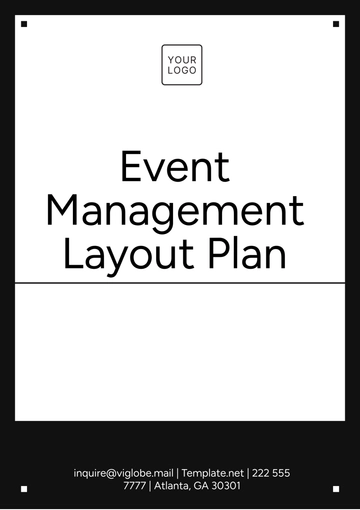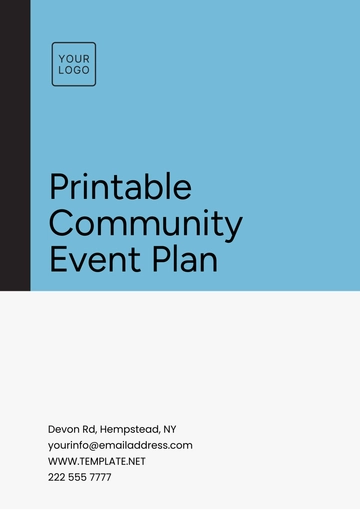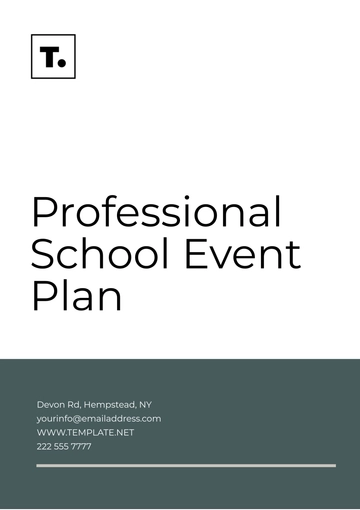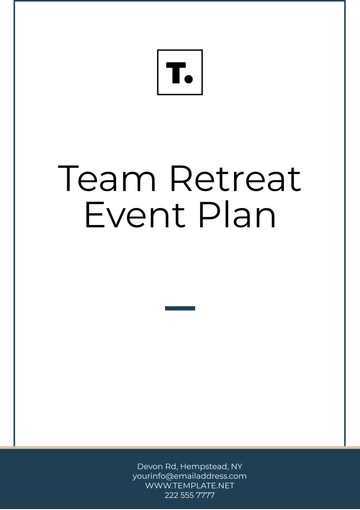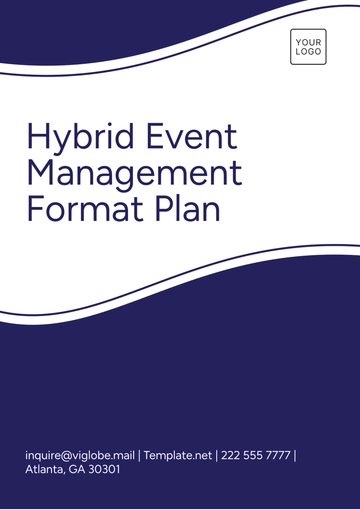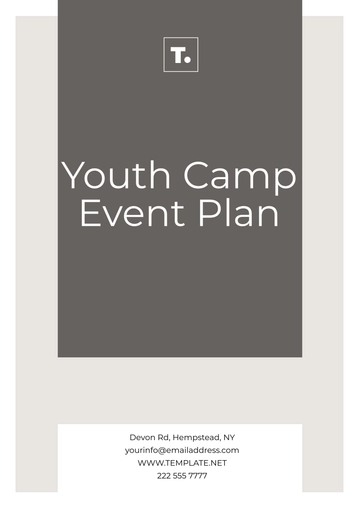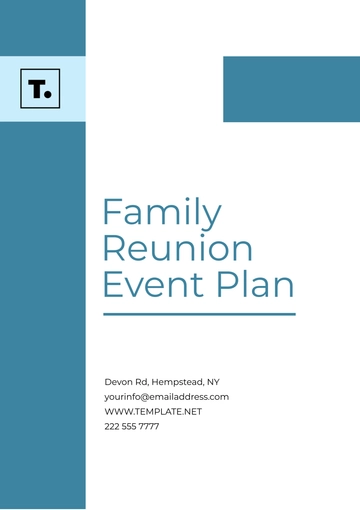Free Family Reunion Event Plan
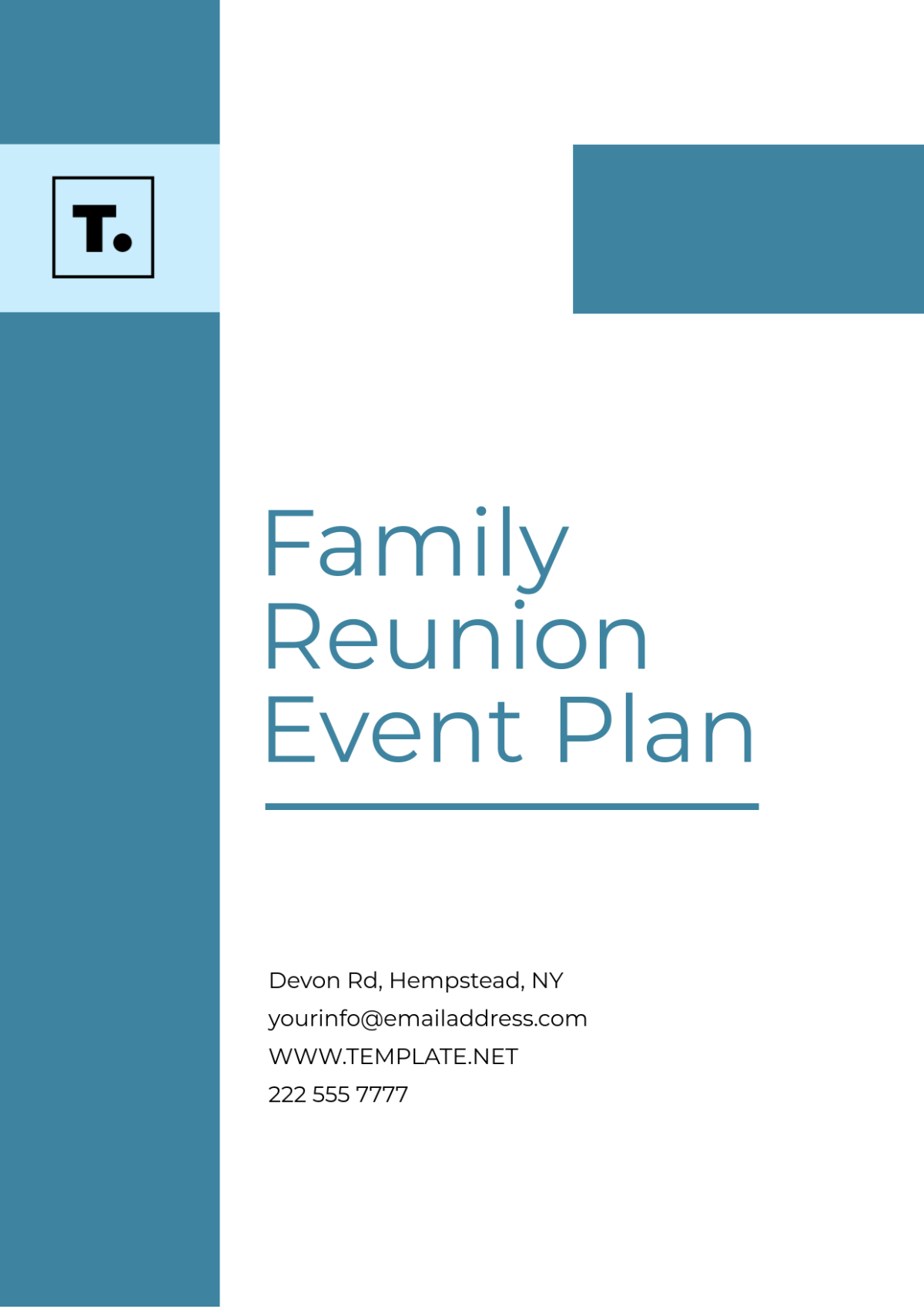
I. Introduction
A family reunion is an opportunity to reconnect, celebrate shared heritage, and create lasting memories. This guide provides a step-by-step approach to help you organize an enjoyable, well-coordinated reunion that reflects your family’s unique character.
II. Initial Planning
A. Setting the Date
Selecting a date that works for the majority of family members is critical. Aim for weekends, holiday breaks, or summer vacations when families are more likely to be available. To maximize participation, send out a preliminary poll or survey to determine the best possible date.
B. Choosing a Location
Decide whether your reunion will be a single-day event or a multi-day gathering. When selecting a location, consider:
Accessibility: Ensure it is easy for most attendees to reach.
Suitability: The venue should accommodate the number of guests and the type of activities planned, whether that’s a park, community center, or a family member's home.
C. Creating a Budget
A well-thought-out budget is essential to keep expenses under control. Estimate costs for all key elements:
Item | Estimated Cost |
|---|---|
Venue | $500 |
Food | $300 |
Activities | $200 |
Decorations | $100 |
Miscellaneous | $50 |
Total | $1,150 |
Consider collecting contributions from family members to cover costs, or designate specific items (like food or decorations) for volunteers to donate.
III. Communication
A. Invitations
Design and send out personalized invitations at least three months before the reunion. Make sure to include important details such as:
Date and time
Venue location
RSVP instructions, including a deadline for responses
Options for dietary preferences or contributions (if it's a potluck)
Digital invitations via email or family social media groups can be effective for larger families.
B. Event Updates
To maintain communication, use a family website, group chat, or social media page where you can post updates, reminders, and important information. Regular communication will help keep everyone on the same page and excited for the event.
IV. Event Details
A. Schedule of Activities
Create a structured but flexible schedule to ensure a smooth flow of events:
Opening Speech and Welcome: A warm introduction to kick off the event, possibly led by a senior family member.
Family Games and Activities: Organize interactive activities like scavenger hunts, relay races, or trivia games that can engage all ages.
Group Picture: Schedule a time for a family group photo to capture the moment.
Meal and Refreshments: Allow time for everyone to enjoy a meal together.
Closing Remarks: Wrap up with a heartfelt thank you to attendees and volunteers, and discuss potential plans for future reunions.
B. Catering and Refreshments
When planning the meal, be mindful of dietary restrictions or preferences. Options include:
Hiring a Caterer: If the budget allows, catering can ease the burden of meal preparation.
Potluck: Ask each family to contribute a dish. Coordinate who will bring what to ensure variety and sufficient food for everyone.
C. Decorations
Choose a theme that resonates with your family’s heritage or interests. Possible decoration ideas include:
Family Tree Displays: Create a visual representation of the family lineage.
Photo Boards: Collect and display photos of family members from different generations.
Themed Banners and Table Settings: Coordinate decorations with the chosen theme.
V. Logistics
A. Transportation
Make sure all attendees can easily reach the venue. For out-of-town guests, provide clear directions and offer assistance with transportation if necessary. Consider organizing carpools or arranging shuttle services.
B. Accommodation
For multi-day events or those traveling long distances, provide a list of nearby hotels or vacation rentals. If possible, negotiate group rates with local accommodations.
C. Equipment and Supplies
Ensure the venue is equipped with the necessary tools and materials:
Audio/Visual Equipment: For slideshows, speeches, or family videos.
Tables and Chairs: Verify the number needed for meals and activities.
Games and Activity Materials: Supplies for organized games or children’s activities.
VI. Post-Event
A. Thank You Notes
Within a week of the reunion, send personalized thank-you notes or emails to everyone who attended, and especially to volunteers. Acknowledging their effort makes the event feel even more special.
B. Survey and Feedback
To improve future reunions, ask attendees to provide feedback through a short online survey. Inquire about their favorite activities, suggestions for improvement, and preferences for future gatherings.
C. Reunion Documentation
Compile and share photos, videos, and memorable moments. You can create a digital photo album or a video montage to distribute among family members, ensuring that the reunion’s memories are preserved.
VII. Conclusion
A well-organized family reunion can be a truly special event that strengthens family bonds and creates lasting memories. With detailed planning, thoughtful communication, and collaboration, your reunion will be a cherished occasion that everyone will look forward to for years to come.
- 100% Customizable, free editor
- Access 1 Million+ Templates, photo’s & graphics
- Download or share as a template
- Click and replace photos, graphics, text, backgrounds
- Resize, crop, AI write & more
- Access advanced editor
Plan the perfect family gathering with the Family Reunion Event Plan Template from Template.net. This fully customizable and editable template ensures seamless event planning, tailored to your needs. Editable in our AI Editor Tool, it offers convenience and flexibility, allowing you to make quick adjustments and create an unforgettable family reunion.
You may also like
- Finance Plan
- Construction Plan
- Sales Plan
- Development Plan
- Career Plan
- Budget Plan
- HR Plan
- Education Plan
- Transition Plan
- Work Plan
- Training Plan
- Communication Plan
- Operation Plan
- Health And Safety Plan
- Strategy Plan
- Professional Development Plan
- Advertising Plan
- Risk Management Plan
- Restaurant Plan
- School Plan
- Nursing Home Patient Care Plan
- Nursing Care Plan
- Plan Event
- Startup Plan
- Social Media Plan
- Staffing Plan
- Annual Plan
- Content Plan
- Payment Plan
- Implementation Plan
- Hotel Plan
- Workout Plan
- Accounting Plan
- Campaign Plan
- Essay Plan
- 30 60 90 Day Plan
- Research Plan
- Recruitment Plan
- 90 Day Plan
- Quarterly Plan
- Emergency Plan
- 5 Year Plan
- Gym Plan
- Personal Plan
- IT and Software Plan
- Treatment Plan
- Real Estate Plan
- Law Firm Plan
- Healthcare Plan
- Improvement Plan
- Media Plan
- 5 Year Business Plan
- Learning Plan
- Marketing Campaign Plan
- Travel Agency Plan
- Cleaning Services Plan
- Interior Design Plan
- Performance Plan
- PR Plan
- Birth Plan
- Life Plan
- SEO Plan
- Disaster Recovery Plan
- Continuity Plan
- Launch Plan
- Legal Plan
- Behavior Plan
- Performance Improvement Plan
- Salon Plan
- Security Plan
- Security Management Plan
- Employee Development Plan
- Quality Plan
- Service Improvement Plan
- Growth Plan
- Incident Response Plan
- Basketball Plan
- Emergency Action Plan
- Product Launch Plan
- Spa Plan
- Employee Training Plan
- Data Analysis Plan
- Employee Action Plan
- Territory Plan
- Audit Plan
- Classroom Plan
- Activity Plan
- Parenting Plan
- Care Plan
- Project Execution Plan
- Exercise Plan
- Internship Plan
- Software Development Plan
- Continuous Improvement Plan
- Leave Plan
- 90 Day Sales Plan
- Advertising Agency Plan
- Employee Transition Plan
- Smart Action Plan
- Workplace Safety Plan
- Behavior Change Plan
- Contingency Plan
- Continuity of Operations Plan
- Health Plan
- Quality Control Plan
- Self Plan
- Sports Development Plan
- Change Management Plan
- Ecommerce Plan
- Personal Financial Plan
- Process Improvement Plan
- 30-60-90 Day Sales Plan
- Crisis Management Plan
- Engagement Plan
- Execution Plan
- Pandemic Plan
- Quality Assurance Plan
- Service Continuity Plan
- Agile Project Plan
- Fundraising Plan
- Job Transition Plan
- Asset Maintenance Plan
- Maintenance Plan
- Software Test Plan
- Staff Training and Development Plan
- 3 Year Plan
- Brand Activation Plan
- Release Plan
- Resource Plan
- Risk Mitigation Plan
- Teacher Plan
- 30 60 90 Day Plan for New Manager
- Food Safety Plan
- Food Truck Plan
- Hiring Plan
- Quality Management Plan
- Wellness Plan
- Behavior Intervention Plan
- Bonus Plan
- Investment Plan
- Maternity Leave Plan
- Pandemic Response Plan
- Succession Planning
- Coaching Plan
- Configuration Management Plan
- Remote Work Plan
- Self Care Plan
- Teaching Plan
- 100-Day Plan
- HACCP Plan
- Student Plan
- Sustainability Plan
- 30 60 90 Day Plan for Interview
- Access Plan
- Site Specific Safety Plan




